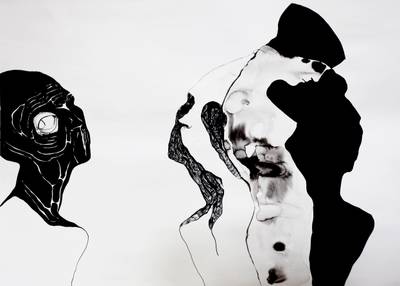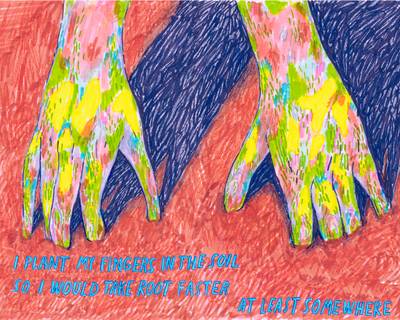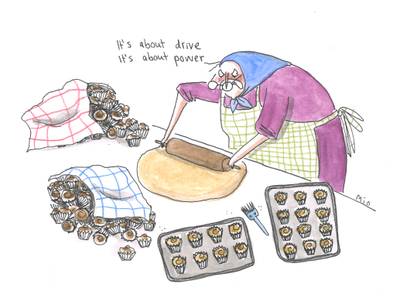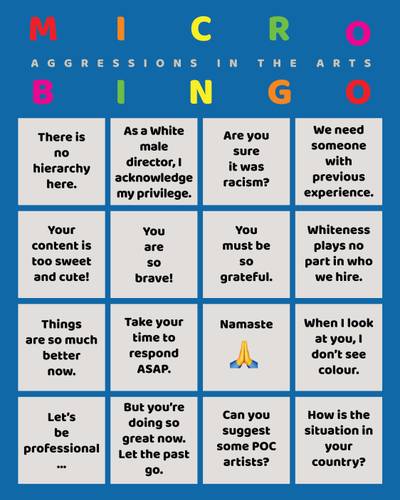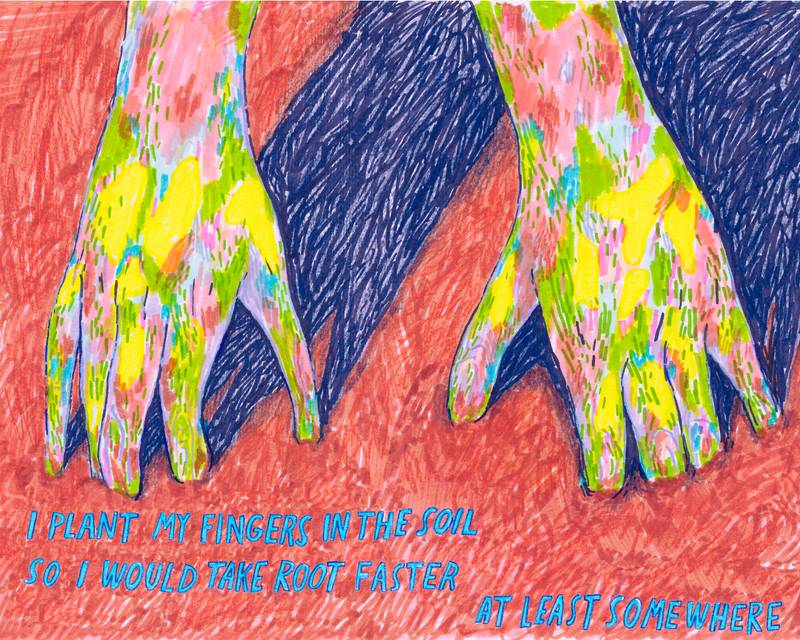

Minkki Nurmi, Hands in the soil, 2021
Hector Sanchez (he/him/él) is a Mexican anthropologist who has been building his career, empathy, and critical thinking on a transnational journey. Having been living in Mexico, Ireland, India, and Finland, he specialized in the fields of Indigenous Studies, Interethnic Conflicts, Contemporary Music, and more recently, Hip hop Studies. He is currently interested in inquiring the value of subaltern contemporary music for Indigenous peoples and how they shape the global music market.
Aggressive Land Use and Kindness: How to Build Radical Care Action on a Damaged Planet
I remember the day when I knew the COVID-19 pandemic was a real thing. It was in mid-March in 2020, after a professor in my university said that nobody knew if we were going to meet in our regular in-person classes the following week. The idea of having our lives trapped indoors gave me a feverish chill. What is going to happen with our futures and the collective well-being? I was worried not only about humanity but also about the world as a living organism. I was wondering whether this pandemic would change our perception of the position that humans have in the world, with the rest of beings that are part of the present reality. Perhaps being trapped at home would afford us to take the time to analyze what happens around us, and build a care relationship with our surroundings.
Building care in the present time could be one of the ways to cope with an unprecedented moment such as the COVID-19 pandemic, a momentum to reflect on many struggles that humanity has been experiencing for a long time. These struggles such as housing crisis, domestic violence, food insecurity, lack of a community feeling in our global society, among many others are structural obstacles to empathy with ourselves, other humans, and those other than humans. We have to dismantle those structural obstacles towards care, the most insidious of which is aggressive land use. In this issue, we refer to aggressive land use as the degradation of the earth, the commodification of our surroundings for-profit purposes, and the indifference towards the relationship between humans and the environment, a relationship that does not have a voice but has a presence. Care questions the role that humans have in the present time, and to what extent we have created a world that constantly punishes those living beings who surround us.
Care action and the intersection between art and nature
What is care after all? What is its relationship with the land? In this issue of NO NIIN x Baltic Circle Festival, we understand care as an action that goes beyond humans, and as an urgent matter that transcends struggles in today’s world. Care matters, as it acknowledges what we should pay attention to, what vulnerability is, and whose voices matter. For Joan Tronto (1993), care is everything we do to maintain reality as it is now, and what we do to repair the damages that the present time has so that we can live in harmony. “The world includes our bodies, ourselves, and our environments; all of which we seek to interweave in a complex, life-sustaining we” (1993, 103).
Valle compares the flights of birds to the detachment of humans from nature. By wondering why humans try to get away from any relationship with the land, he asks questions about love, life, death, and how they can be compared to natural cycles.
The notion of care, without question, changed dramatically since last year as the search to repair reality became a common ideal. But what if we repair the reality by re-shaping our co-existence with the other than the human world? Artistic expressions can help us to start visualizing this new reformulated relationship. After a long period of silence in live artistic acts since last year, we have realized how powerful live art can be to build a sense of kindness among strangers that are standing at the same place, same time, enjoying the same live act. A kindness that could be an initial point for a radical care action. Art can make visible that care is not only a human relationship, and that is the central point of the Baltic Circle Festival and this current Issue. Taking, for example, the words of the Sámi rapper Ailu Valle, one of the performers at this year’s festival, in the song Girddašit, seivvodit (Flying, landing):
I fly south overwinter, then return home again
Is it grace when the cycle is forever?
Towards south in autumn, I come back in spring again
Is this need of landing our enemy?
Or dangerous, or why we
Want to detach ourself from land so badly?1
Valle compares the flights of birds to the detachment of humans from nature. By wondering why humans try to get away from any relationship with the land, he asks questions about love, life, death, and how they can be compared to natural cycles. In this example, he uses art to analyse reality through a more equal relationship between the human and the other than the human world.
By seeing the world as a network of relationships, in which humans are only another element and not the center per se, the aggressive land use could be dismantled. “The world is not an external domain of objects that I look at, or do things to, but is rather going on, or undergoing continuous generation, with me and around me” (Ingold, 2000, 108). If we give to the land the agency of a living being and we situate ourselves as part of a larger living organism, which is the world, those atrocities committed to the environment will be easier to visualize.
Perceptions of a catastrophe
While care is our starting point for this issue, it simultaneously highlights the need to amplify an understanding of reality with a variety of experiences: to hear ‘other ontologies’ and to include the ‘other than human’ actors in this reflection. As such, the contributors in this collaborative issue shed light on experiences of aggressive land use and how both humans and the earth have fought against a money-spinning world to maintain an equilibrium in the “here and the now”.
Writing and combining text with the living world is a powerful action to make space for the many ways of knowing, emphasizing the resilience of those who have been building an earthling care even before our pandemic world. This issue is an attempt at “learning to learn from below”, as addressed by the Sámi author Rauna Kuokkanen: “Learning to learn from below requires a radical revision of previously held assumptions and conceptions of learning. It requires a willingness to stretch into different modes of perceiving the human relationship to the world and depends on the recognition of the human responsibilities towards that interdependence” (2017, 322-323). It is through the words of justice that we pass the voice to all those resilience movements that visualize care not merely as a phenomenon of kindness and togetherness.
Care seeks to make visible the suffering of those other than human actors. That said, the essays in this issue touch upon burdens such as industrialization, destruction, extractivism, and deforestation. Nonetheless, they also portray their resilience counterpart, with ideas coming from Indigenous resilience, emotional attachment, and the many ways of building care against the odds. Ingrid Fadnes in “The silent forest”, touches upon the industrialization of Extremo Sul in the State of Bahia (Brazil) and how this slow death of an ecosystem has been explained through history and storytelling, settling at the same level of importance written-based and oral explanations of such degradation. Helga West, in contrast, in “The doll essay”, sheds light on the objectification of the Sámi people on plastic dolls, and how this phenomenon explains the extractive use of land in the Sápmi territory in the Nordics, as a quest for a plastic treasure below the land. Lastly, Anna Varfolomeeva’s essay called “Productive Bodies, Care and Destruction” approaches the involvement of the Veps people in Karelia (Russia) in heavy industry, and how the prioritization of productivity over health from industrial workers creates a “destructive self-care”, seeing in this way the effects of industrialization in bodily exploitation.
From Sápmi to Karelia and Brazil, their words show how across the world, ‘aggressive land use’ prevents us from achieving an earthling global solidarity, and it is through a radical care action that we will visualize how the earth can heal our scars.
